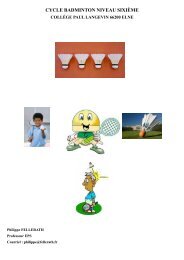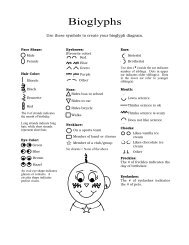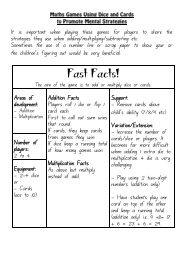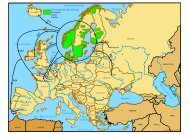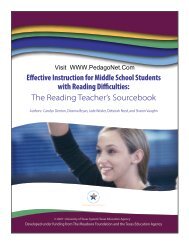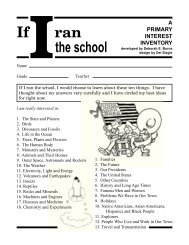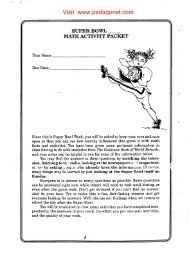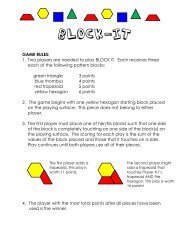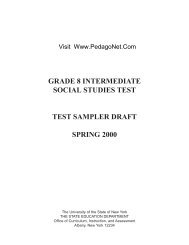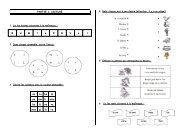You also want an ePaper? Increase the reach of your titles
YUMPU automatically turns print PDFs into web optimized ePapers that Google loves.
<strong>Butterflies</strong> <strong>and</strong> <strong>Moths</strong>Teacher’s GuideClassroom ActivitiesFlorida Museum of Natural HistoryEducation DepartmentExhibits <strong>and</strong> Public ProgramsHull Road <strong>and</strong> 34th StreetUniversity of FloridaGainesville, FL 32611352-846-2000http://www.flmnh.ufl.edu
Teacher’s GuideTITLE: Butterfly RainforestGRADE LEVEL: Kindergarten through 12 th gradePROGRAM DESCRIPTION: Students will explore an outdoor walk-through environment <strong>and</strong>visual displays where they will learn more about the life cycle of a butterfly, <strong>and</strong> gain a betterunderst<strong>and</strong>ing of how important camouflage <strong>and</strong> adaptive methods are for survival.LEARNING GOALS: Activities are designed to integrate science, language arts, math <strong>and</strong> socialstudies. At the conclusion of the museum program, kindergarten through 2 nd grade studentsshould1. Use listening strategies effectively (LA.C.1.1)2. Underst<strong>and</strong> the patterns of function in living things (SC.F.1.1, SC.F.1.2, SC.F.1.3, SC.F.1.4)3. Underst<strong>and</strong> the competitive, interdependent, cyclic nature of living things in theenvironment (SC.G.1.1, SC.G.1.2, SC.G.1.3, SC.G.1.4)4. Underst<strong>and</strong> the consequences of using limited natural resources (SC.G.2.1, SC.G.2.2)5. Underst<strong>and</strong> the scientific processes <strong>and</strong> habits of mind to solve problems (SC.H.1.1,SC.H.1.5)In addition, 3 rd through 5 th grade students should1. Know that all living animals depend on plants. (SC.F.1.2.3)2. Know that all living things compete in a climatic region with other living things <strong>and</strong>structural adaptations make them fit for an environment. (SC.G.1.2.2)3. Know that all living things must compete for earth’s limited resources; organisms bestadapted to compete for available resources will be successful <strong>and</strong> pass their adaptations(traits) to their offspring. (SC.G.2.2.1)4. Know that the size of the population is dependent upon the available resources within thecommunity. (SC.G.2.2.2)In addition, 6 th through 8 th grade students should1. Underst<strong>and</strong> the process <strong>and</strong> importance of genetic diversity (SC.F.2.3)2. Underst<strong>and</strong> the consequences of using limited natural resources. (SC.G.2.3, SC.G.2.3.3,SC.G.2.3.4)In addition, 9 th through 12 th grade students shouldUnderst<strong>and</strong> how genetic variation of offspring contributes to population control in anenvironment, <strong>and</strong> that natural selection ensures that those who are best adapted to theirsurroundings survive to reproduce. (SC.G.2.4.3)Florida Museum of Natural Historyhttp://www.flmnh.ufl.edu
Contentspage167101417202231323439404143444648topicTeacher InformationWords to KnowWhat is an Insect?Lesson One (ages primary <strong>and</strong> intermediate)Figure 1, Figure 2<strong>Butterflies</strong> <strong>and</strong> UsLesson Two (ages primary <strong>and</strong> intermediate)Figure 3, Activity Sheet 1Butterfly Anatomy: C<strong>and</strong>y <strong>Butterflies</strong>Lesson Three (ages primary <strong>and</strong> intermediate)Butterfly vs. Moth: Do you see the difference?Lesson Four (ages primary <strong>and</strong> intermediate)Figure 4, Activity Sheet 2Butterfly vs. Moth: Antennae ActivityLesson Five (ages primary)Figure 5Butterfly vs. Moth: Wings to WearLesson Five extension (ages primary <strong>and</strong> intermediate)Figures 6.1 - 6.6Butterfly vs. Moth ReviewLesson Six (ages primary <strong>and</strong> intermediate)Activity Sheet 3Life Cycle: IntroductionLesson Seven (ages primary <strong>and</strong> intermediate)Figure 7Life Cycle: Metamorphosis mobileLesson Eight (ages primary)Figures 8.1 - 8.4Life Cycle: Metamorphosis DiagramLesson Eight extension (ages primary <strong>and</strong> intermediate)Activity Sheet 4Life Cycle: Metamorphosis ActivityLesson Nine (ages primary)Food <strong>and</strong> Finding ItLesson Ten Activity (ages primary)Mating: Following a Scent TrailLesson Eleven Activity (ages primary <strong>and</strong> intermediate)Mating: Locating a Host PlantLesson Twelve Activity (ages primary, intermediate, <strong>and</strong> advanced)Predator Avoidance: CamouflageLesson Thirteen Activity (ages primary <strong>and</strong> intermediate)Additional Resources
Teacher Information<strong>Butterflies</strong> <strong>and</strong> moths are second only to beetles as the largest group of animals in the world.Even with the 165,000 species of butterflies <strong>and</strong> moths that have been described, thereare still an estimated 100,000 species that have not. <strong>Butterflies</strong> <strong>and</strong> moths are insects thatscientists call Lepidoptera, meaning, “scale winged” in Greek. They get this name fromthe tiny scales covering their wings <strong>and</strong> body. Like all insects, Lepidoptera have a hard outercovering called an exoskeleton, which is divided into sections <strong>and</strong> has joints so the animalcan move. Also like other insects, moths <strong>and</strong> butterflies have six legs, a head, a thorax, <strong>and</strong>an abdomen.Fun Fact: There are 125 Lepidoptera families <strong>and</strong> about 12 times as many moths asbutterflies − approximately 240,000 moths <strong>and</strong> 20,000 butterflies.Anatomy<strong>Butterflies</strong> <strong>and</strong> moths have three major body sections, a head, a thorax, <strong>and</strong> an abdomen.On the head are two compound eyes, a proboscis, <strong>and</strong> the points of attachments for twoantennae.Eyes:Proboscis:Antennae:Lepidoptera eyes have hundreds of lenses, each focusing on a narrow areaof the surrounding environment. This is known as a compound eye.The proboscis is a long straw-like tube that unrolls from the head when thebutterfly needs to take either food or water for its liquid diet.Antennae extend out of the dorsal side of the head, from between theeyes. These organs act as the insect’s nose <strong>and</strong> aid in finding food, mating,<strong>and</strong> balancing during flight.The thorax is divided into three segments, each with a pair of legs. The four wings of abutterfly or moth are also attached to the thorax which houses the muscles needed formaking these wings <strong>and</strong> legs move.Legs:Wings:<strong>Butterflies</strong> <strong>and</strong> moths have six segmented legs.The wings are composed of two membrane layers that are supported by tubularveins <strong>and</strong> are covered in thous<strong>and</strong>s of colorful scales. Wing color <strong>and</strong> patternserve a variety of purposes, from attracting mates to warning predators orproviding camouflage.The abdomen is composed of ten segments <strong>and</strong> contains the majority of the insect’sorgans such as the heart, breathing pores or spiracles, most of the digestive system, <strong>and</strong>reproductive organs.Florida Museum of Natural History http://www.flmnh.ufl.edu 1
Teacher InformationForewingThoraxHeadAntennaeHindwingAbdomenLegsCompound eyeProboscisButterfly or MothThere are three major differences between butterflies <strong>and</strong> moths;1) <strong>Butterflies</strong> are often more colorful than moths because butterflies are active duringthe day. <strong>Moths</strong>, active at night, have earthy colors to camouflage them while theysleep during the day.2) Most butterflies have club-shaped antennae while a moth’s antennae are featherlikeor taper to a point.3) <strong>Moths</strong> have a thicker coating of scales than butterflies, gving them a furryappearance. This differs from butterflies because moths fly at night <strong>and</strong> are notusually active during the day when the sun would warm their bodies.Food <strong>and</strong> Finding It<strong>Butterflies</strong> <strong>and</strong> moths feed on a wide variety of liquids for energy <strong>and</strong> reproduction. Thoughfamous for their affinity to flower nectar, butterflies <strong>and</strong> moths often feed on less appetizingitems, such as feces, sap, rotten fruit <strong>and</strong> decomposing animals. All butterflies drink water,but male butterflies also drink liquids to obtain minerals vital to reproduction.Florida Museum of Natural Historyhttp://www.flmnh.ufl.edu2
Teacher Information<strong>Butterflies</strong> <strong>and</strong> moths rely on different senses to help them find food. Because butterfliesare active during the day, color plays an important role in survival. Brightly colored flowersadvertise food sources. However, moths are usually only active at night <strong>and</strong> cannot relyon visible color to help them find food. Instead, moths rely on smell. <strong>Moths</strong>’ feather-likeantennae have greater surface area than the club-shaped antennae of butterflies. Thisallows them to detect scents. <strong>Moths</strong> are often attracted to night-blooming flowers withstrong smells.MatingFor butterflies, bright display colors are important in mating rituals <strong>and</strong> courtship displays.Male butterflies are often much brighter than females because they use their colors toattract the attention of potential female mates. Since finding a mate at night or in dimlylit forests can be troublesome, female moths <strong>and</strong> some species of butterflies produce largeamounts of pheromones, a kind of chemical perfume. Using their antennae, males c<strong>and</strong>etect the pheromones of potential mates from great distances.If the courtship display of the male is successful, the female will alight on a leaf or theground <strong>and</strong> let the most aggressive or most colorful male mate with her. After mating, afemale carefully searches for the correct food plant for eggs <strong>and</strong> future larvae. Becauseeach species of butterfly or moth is adapted to eat specific species of plants, females arevery selective about where they lay their eggs. These plants are called “host plants.” Thefemale butterfly instinctively recognizes the correct leaf shape, color, odor, taste, <strong>and</strong>appearance of this host plant. Once satisfied, she lays her eggs, coating them with anadhesive that fastens them to the leaf.Life CycleThere are 4 life cycle stages for all butterflies <strong>and</strong> moths: egg, larva (or caterpillar), pupa,<strong>and</strong> adult. This cycle is called complete metamorphosis.Florida Museum of Natural History http://www.flmnh.ufl.edu 3
Teacher InformationThe first stage of an insect’s life is an egg. When the egg hatches the young butterfly ormoth is called a caterpillar or larva. A caterpillar spends most of its time feeding on plants<strong>and</strong> growing very quickly. When it has reached its full size, the caterpillar stops feeding <strong>and</strong>becomes a pupa. A moth pupa transforms inside a cocoon <strong>and</strong> a butterfly pupa transformsinside a chrysalis. During this immobile, but metabolically active stage, the butterfly ormoth makes its transformation from wingless larva to winged adult.Predator AvoidanceSome animals (for example, birds, bats, spiders, dragonflies, <strong>and</strong> mice) rely heavily onLepidoptera for food. <strong>Butterflies</strong> <strong>and</strong> moths have evolved several ways to avoid being eaten.These include:Warning coloration- a bold pattern <strong>and</strong> bright contrasting colors. Bright warning coloration,especially yellow-<strong>and</strong>-black, orange, or red, warn birds <strong>and</strong> other predators that such insectsmay bite, sting, or taste bad.Camouflage- <strong>Moths</strong> <strong>and</strong> many butterflies, particularly females, have earth-tone colors orpatterns that resemble tree bark, lichens, or leaves. This “cryptic coloration” allows them toavoid predators by blending into their surroundings.Mimicry- Some butterflies <strong>and</strong> moths deter predators by mimicking the color pattern of otherless edible species or other insects, plants, <strong>and</strong> animals.There are two types of mimicry:1) Batesian MimicrySome harmless Lepidoptera species mimic the appearance of other species that arepoisonous or distasteful. They “pretend” to be poisonous <strong>and</strong> predators avoid them.2) Mullerian MimicrySometimes two species look alike <strong>and</strong> both are poisonous or distasteful. When apredator attacks one of the two, it remembers the color pattern <strong>and</strong> is unlikely toattack either, avoiding insects with that color pattern.Defense patterns- Alarm Patterns: Eyespots on wings intimidate predators, especially smallbirds, who think they see the eye of a larger bird that might harm them.Habitat<strong>Butterflies</strong> <strong>and</strong> moths can be found all over the world. However, the world’s greatestdiversity of butterflies <strong>and</strong> moths can be found in tropical rainforests. This means that thereare a great number of different species in areas close to the equator.Florida Museum of Natural History http://www.flmnh.ufl.edu 4
Teacher InformationTropical rainforests are home to such diversity for several reasons. The first is that overthe past 100 million years, l<strong>and</strong>s near the equator remained fairly undisturbed by sea levelchange, climate change, or glaciation. This allowed many different animals <strong>and</strong> plants toevolve over long periods of time. Because there are no seasons along the equator, onlyconstant high temperatures, lots of humidity <strong>and</strong> rainfall, <strong>and</strong> intense sunlight, conditionsare perfect for the growth of thous<strong>and</strong>s of plant species. Diverse rainforest plants providehighly varied resources for animal life, <strong>and</strong> have evolved into thous<strong>and</strong>s of species.Butterfly <strong>and</strong> moth species live at specific heights in the rainforest. In a typical rainforestthere are at least 4 layers or strata:1) Ground layer or Forest Floor- herbs, ferns, <strong>and</strong> low shrubs2) Understory layer- shade-tolerant small trees, mosses, lichens, ferns3) Canopy layer- tops of tall trees, as many as 400 species per square mile4) Emergent layer- extraordinarily tall species that rise above the canopy layer.Most Lepidoptera species rarely leave a familiar environment. Some live hundreds of feethigh in the rainforest canopy, while others fly close to the ground or rest in leaf litter. Eachis adapted to a certain temperature, humidity, <strong>and</strong> light range, <strong>and</strong> stays at its favoritestrata.Florida Museum of Natural History http://www.flmnh.ufl.edu 5
Words to Knowarthropod- an animal grouped in Phylum Arthropoda; invertebrates such as insects, spiders,<strong>and</strong> crustaceans. Arthropods have a segmented body, jointed legs, <strong>and</strong> an exoskeleton.butterfly garden- a garden designed to attract butterflies <strong>and</strong> provide food for their larvaeconservation- planned management of a natural resource to prevent exploitation,destruction, or neglect; wise use of resourcescocoon- the outer covering of a moth’s pupacompound eye- an insect eye which is made up of many separate (6-sided lens) unitscryptic coloration- an animal that is colored to blend in with it’s surroundingsdiversity- the number <strong>and</strong> variety of species present in an area <strong>and</strong> their spatial distributionegg- the first stage in the life cycle of an insectendangered- a species whose numbers are so low that the entire species is at risk ofextinctionevolution- the process of change in life forms over many generations that can lead to newspeciesexoskeleton- external skelton usually made of chitinextinct- no longer existinginsect- an animal grouped in Class Insecta of Phylum Arthropoda with well-defined head,thorax, <strong>and</strong> abdomen, three pairs of legs, <strong>and</strong> typically one or two pairs of wingsInvertebrate- an animal without a backbone or spinal columnlarva- (plural: larvae) A young butterfly or moth (or other insect) from the time that ithatches from the egg until it becomes a pupa, or chrysalis. During this time it usually moltsseveral times, <strong>and</strong> may change its form or color each time.Lepidoptera- insects grouped in Order Lepidoptera are butterflies <strong>and</strong> moths. They havefour wings covered in scales, six legs, an exoskeleton, two antennae, compound eyes, threebody parts- head, thorax, abdomen, <strong>and</strong> undergo complete metamorphosislight pollution- lights that confuse, distract, <strong>and</strong> disrupt animals at nightmicrolepidoptera- minute or tiny mothsmetamorphosis- the transformation of a larval insect into it’s winged adult formmimicry- when plants <strong>and</strong> animals <strong>and</strong> plants look or act like another species to gainprotection <strong>and</strong> increase survivalproboscis- the straw-like sucking mouthpart of butterflies <strong>and</strong> mothspupa- (plural: pupae) the stage of an insect’s life when it transforms from larva into adultrain forest- a forest with annual rainfall of at least 100 inches (254 centimeters) <strong>and</strong> tallevergreen trees forming a continuous canopyspiracle- the breathing holes in the abdomen of a butterfly or mothvertebrate- an animal with a spinal columnwarning coloration- an animal that is brightly colored (usually yellow, black, <strong>and</strong>/or red) towarn other animals that it is dangerous or toxicFlorida Museum of Natural History http://www.flmnh.ufl.edu 6
What is an Insect?Lesson OneAges Primary <strong>and</strong> IntermediateObjective: Students will underst<strong>and</strong> the characteristics of insectsMaterials:Picture of beetles (Figure 1)Picture of human skeleton (Figure 2)Suggested approach:Ask the children “What is an insect?” Listen to their responses. Explain to them that insectshave several major characteristics:Part 1Insects do not have an internal skeleton but instead have a hard outer covering called anexoskeleton. This exoskeleton is made up of a series of overlapping segments, allowingflexible motion.Show the children a picture of a skeleton (see attached sheet). Explain to them that peoplehave bones like this inside of them <strong>and</strong> that all these bones make up a skeleton. Ourskeleton is important because it supports our body <strong>and</strong> anchors our muscles. Without itwe could not st<strong>and</strong> or move. We would just be a pile of mush. Insects are not like people.They do not have bones. Their skeleton is on the outside of their body. This hard shell iscalled an exoskeleton. Have the children say the word “exoskeleton.”Show the children a picture of a beetle (see attached sheet). See the exoskeleton? Thishard shell helps protect the insect’s body <strong>and</strong> organs. Think of a football helmet or a bicyclehelmet. These helmets work like an exoskeleton because they protect what’s inside.Part 2Insects are in a group of animals called arthropods. The word arthropod is a Greek wordthat means “jointed feet.” Insects also have six jointed legs. People have joints too. Ajoint is the place where two bones come together. Bend your arm at the elbow. Now pointto your elbow. This is a joint. Joints allow your body to bend <strong>and</strong> move. Can you think ofanother joint? Your knee is another joint. People have joints in their legs just like insects.Florida Museum of Natural History http://www.flmnh.ufl.edu 7
What is an Insect?Lesson OneFigure 1exoskeletonexternal skeletonFlorida Museum of Natural History http://www.flmnh.ufl.edu 8
What is an Insect?Lesson OneFigure 2endoskeletoninternal skeletonFlorida Museum of Natural History http://www.flmnh.ufl.edu 9
<strong>Butterflies</strong> <strong>and</strong> UsLesson TwoAges Primary <strong>and</strong> IntermediateObjective: Students are able to describe Lepidoptera (butterfly <strong>and</strong> moth) anatomy <strong>and</strong>relate it to our own anatomyMaterials:4 kaleidoscopeslabeled butterfly illustration (Figure 3)copies of the butterfly anatomy activity sheet (Activity Sheet 1)Suggested approach:Begin a discussion of butterflies <strong>and</strong> moths. Ask your students to give you examples ofinsects. Explain that butterflies <strong>and</strong> moths are both insects that belong to the same group ororder of insects. This order is called Lepidoptera. Like other insects, butterflies <strong>and</strong> mothshave three major body sections, a head, a thorax, <strong>and</strong> an abdomen.Ask the children if they have those three body sections. Tell them that they have all ofthem. Have the children put their h<strong>and</strong>s on their heads. What do we have on our heads?Have the children point to their eyes, nose, ears, mouth, <strong>and</strong> hair.What do butterflies <strong>and</strong> moths have on their heads? Show them a picture of a butterflylabeled (see attached page).<strong>Butterflies</strong> <strong>and</strong> moths have two eyes. People have two eyes too but each of our eyes onlyhas one lens. This means we only see one picture. <strong>Butterflies</strong> <strong>and</strong> moths have hundreds oflenses on each eye. This means that they see lots of little images. This kind of eye is calleda compound eye. Pass around the kaleidoscopes <strong>and</strong> have the children look through them.Tell them this is how a butterfly sees the world.Fun Fact: Though the ability to see detail is very poor compared to humans, butterflies arecapable of seeing a greater range in the color spectrum from ultra-violet through all visiblelight to infrared wavelengths.<strong>Butterflies</strong> <strong>and</strong> moths have two antennae between their eyes. Point to the antennae onthe picture. They use their antennae to feel <strong>and</strong> smell. What do we use to feel <strong>and</strong> smell?Insects do not have h<strong>and</strong>s <strong>and</strong> noses like we do, so they use their antennae.Point to your mouth. <strong>Butterflies</strong> <strong>and</strong> moths have a different kind of mouth. Their mouth iscalled a proboscis. The proboscis is a long straw-like tube that unrolls from the head whenthe butterfly needs to take either food or water for its liquid diet.Florida Museum of Natural History http://www.flmnh.ufl.edu 10
<strong>Butterflies</strong> <strong>and</strong> UsLesson TwoAges Primary <strong>and</strong> IntermediateWhere do you think our thorax is? Have the children put their h<strong>and</strong>s on their chest. This isour thorax. What is attached to a butterfly’s or a moth’s thorax?Point to the legs. <strong>Butterflies</strong> <strong>and</strong> moths have six legs.Point to the wings on the picture. <strong>Butterflies</strong> <strong>and</strong> moths (Lepidoptera) have four wings. Thetop two are called the forewings <strong>and</strong> the bottom two are called the hind wings. Each wing iscovered in thous<strong>and</strong>s of colorful scales. The colors <strong>and</strong> patterns on their wings are alwayssymmetrical. This means that each wing is a mirror image of the other. Hold out your h<strong>and</strong>swith your palms up. Now look at your h<strong>and</strong>s side by side. Your h<strong>and</strong>s are symmetrical.Place the palms of your h<strong>and</strong>s together. See how your fingers line up perfectly together.This is how butterfly wings line up when they come together.Where do you think your abdomen is? Have the children hold their stomach below their bellybutton. This is your abdomen. An insect’s abdomen is usually long. Just like our abdomena butterfly’s abdomen contains the stomach, helps produce baby butterflies, <strong>and</strong> gets rid ofwaste.Have the children read <strong>and</strong> fill out the diagram of a butterfly’s anatomy (Activity Sheet 1) onthe following page.Florida Museum of Natural History http://www.flmnh.ufl.edu 11
<strong>Butterflies</strong> <strong>and</strong> UsLesson TwoFigure 3Florida Museum of Natural History http://www.flmnh.ufl.edu 12
<strong>Butterflies</strong> <strong>and</strong> UsLesson TwoActivity Sheet 1Read the definitions <strong>and</strong> label the diagram below.Abdomen - The abdomen is the segmentedtail area of an insect that contains the heart,trachea (breathing tubes), reproductiveorgans, <strong>and</strong> most of the digestive system.Antenna - An antenna is a sensory appendagethat is attached to the head of adult insects.Antennae are used for the sense of smell <strong>and</strong>balance. <strong>Butterflies</strong> have two antennae withclubs at the end.Compound Eye - Insect compound eyes aremade up of many hexagonal lenses.Forewing - The fore wings are the two upperwings.Hindwing - The hind wings are the two lowerwings.Head - The head is the part of the insect thatcontains the brain, two compound eyes, theproboscis, <strong>and</strong> the pharynx (the start of thedigestive system). The two antennae areattached to the head.Leg - Adult Lepidoptera (butterflies <strong>and</strong>moths) have six legs. The two forelegs ofsome butterfly species are tiny.Proboscis - Adult butterflies sip nectar<strong>and</strong> other liquids using a spiral, straw-likeproboscis located on their head.Thorax - The thorax is the body sectionbetween the head <strong>and</strong> the abdomen. The legs<strong>and</strong> wings attach to the thorax.Florida Museum of Natural History http://www.flmnh.ufl.edu 13
Butterfly Anatomy: C<strong>and</strong>y <strong>Butterflies</strong>Lesson ThreeAges Primary <strong>and</strong> IntermediateObjectives: Children will make butterflies to help them underst<strong>and</strong> the anatomy of abutterfly.Materials for each child:1 paper plate 3 Tbs. vanilla frosting4 toothpicks 1 c<strong>and</strong>y fruit slices2 unbroken pretzels 1 gumdrop2 mini M&Ms 1 large marshmallow1 two-inch piece red shoelace licorice paper towels6 half inch pieces black shoelace licoriceNote: Make sure to buy a little extra in case pieces get dropped on the ground or broken.Before Class1. Buy enough c<strong>and</strong>y <strong>and</strong> supplies for each child in your class to have the materials listedabove.2. Place the appropriate amount of c<strong>and</strong>y on a paper plate <strong>and</strong> make one for each child inthe class.3. Place one half container of vanilla frosting at every workstation (the children will usethis to “glue” body parts together).4. Make sure to place plenty of paper towels at each workstation.5. Write a key on the board or place a printout of it at each desk as to what piece of c<strong>and</strong>yrepresents what butterfly body part.During Class1. Start class by showing them a picture of a butterfly (see Figure 4, p.18).2. Review the three main body sections (head, thorax, <strong>and</strong> abdomen) <strong>and</strong> their components(See following page for review sheet <strong>and</strong> key).3. Tell the class that everyone is going to build their own butterfly out of c<strong>and</strong>y but theyhave to make sure not to eat the pieces until everyone is finished.Florida Museum of Natural History http://www.flmnh.ufl.edu 14
Butterfly Anatomy: C<strong>and</strong>y <strong>Butterflies</strong>Lesson ThreeAges Primary <strong>and</strong> IntermediateMaking the C<strong>and</strong>y Butterfly1. Put the head (gumdrop) on the end of one of the tooth picks.2. Slide the thorax (large marshmallow) on the tooth pick just below the head.3. Slide the abdomen (c<strong>and</strong>y fruit slice) behind the thorax.4. Attach the two wings (pretzels) by pushing the bottom of the pretzel into the topsides ofthe thorax (large marshmallow).5. Attach the legs (black shoelace licorice) by pushing them into the bottom sides of thethorax.6. Insert two antennae (toothpicks) close together into the very top of the head.7. Take the proboscis (red shoelace licorice) <strong>and</strong> coil it.8. Stick the end of the proboscis into the bottom front of the head.9. Dip the eyes (mini M&Ms) in the frosting <strong>and</strong> attach them to the head right beside theantennae.Florida Museum of Natural History http://www.flmnh.ufl.edu 15
Butterfly Anatomy: C<strong>and</strong>y <strong>Butterflies</strong>Lesson ThreeAges Primary <strong>and</strong> IntermediateReview Sheet <strong>and</strong> KeyThe head (gumdrop) is has two compound eyes, a proboscis, <strong>and</strong> two antennae.Eyes: (mini M&Ms)Each eye of a butterfly has hundreds of lenses. This is known as a compound eyeProboscis: (red shoestring licorice)The proboscis is a long straw-like tube that unrolls from the head when the butterfly needsto take either food or water for its liquid diet.Antennae: (toothpicks)The antennae extend out of the top of the head, from between the eyes <strong>and</strong> end in athickened or club like structure. These organs act as the insect’s nose <strong>and</strong> aid in findingfood, mating, <strong>and</strong> balancing during flight.The thorax (large marshmallow) is divided into three segments, each with a pair of legs.The four wings of a butterfly or moth are also attached to the thorax which houses themuscles needed for making the wings <strong>and</strong> legs move.Legs: (black shoestring licorice)<strong>Butterflies</strong> <strong>and</strong> moths have six segmented legs.Wings: (pretzels)<strong>Butterflies</strong> <strong>and</strong> moths have two sets of wings. The front two are called forewings while therear two are called hind wings. The wings are covered in thous<strong>and</strong>s of colorful scales.The abdomen (c<strong>and</strong>y fruit slices) is long <strong>and</strong> contains the majority of the butterfly’sorgans such as the heart, breathing pores or spiracles, most of the digestive system, <strong>and</strong>reproductive organs.Florida Museum of Natural History http://www.flmnh.ufl.edu 16
Butterfly vs. Moth: Do you see the difference?Lesson FourAges Primary <strong>and</strong> IntermediateObjective: Students know the differences between butterflies <strong>and</strong> mothsMaterials:Picture of butterfly <strong>and</strong> a moth (Figure 4)Butterfly vs. Moth activity sheet (Activity Sheet 2)Suggested Approach:Show your class a picture of a butterfly <strong>and</strong> a moth (Figure 4). Say to them: “Do you see anydifferences between the two?” Tell your class, “There are three major differences betweenmoths <strong>and</strong> butterflies.”1) <strong>Butterflies</strong> are often more colorful than moths because butterflies are active duringthe day. <strong>Moths</strong> are active at night <strong>and</strong> have earthy colors to camouflage them whilethey sleep during the day.2) Most butterflies have club-shaped antennae or antennae with knobs on the end whilea moth’s antennae are feather-like or taper to a point.3) <strong>Moths</strong> have a thicker coating of scales than butterflies, giving them a furryappearance. These heavy scales help keep them from losing heat during the nightwhen they are most active.Have the children complete Activity Sheet 2 on the following page to see if they know thedifferences between butterflies <strong>and</strong> moths.Florida Museum of Natural History http://www.flmnh.ufl.edu 17
Butterfly vs. Moth: Do you see the difference?Lesson FourFigure 4Florida Museum of Natural History http://www.flmnh.ufl.edu 18
Butterfly vs. Moth: Do you see the difference?Lesson FourActivity Sheet 2Identify each insect by writing butterfly or moth under each picture.Florida Museum of Natural History http://www.flmnh.ufl.edu 19
Butterfly vs. Moth: Antennae ActivityLesson FiveAges PrimaryObjective: Students review the differences beween moth <strong>and</strong> butterfly anatomyMaterials:Picture of butterfly <strong>and</strong> moth antennae (Figure 5)Aluminium foilDifferent colors of pipe cleaners ScissorsClear tapeDrawing paperMarkers <strong>and</strong>/or crayonsSuggested Approach:Ask your class if they remember where the antennae are located on the butterfly or moth.Tell them that antennae are located on the head. Ask the students if they remember thedifference between butterfly <strong>and</strong> moth antennae. Hold up the picture of butterfly <strong>and</strong>moth antennae (Figure 5). Butterfly antennae are long <strong>and</strong> thin with a little knob at theend. That is why they are called club-shaped antennae. Moth antennae are usually thick<strong>and</strong> feathery. Smell is especially important to moths because they fly at night <strong>and</strong> needsome extra help to find food <strong>and</strong> mates. The extra hairs on moth antennae provide a greatersurface area on which to pick up scents.Tell the class that they are going to make their own antennae.Making the Antennae:1. Pass out drawing paper, marker <strong>and</strong>/or crayons, scissors, pipe cleaners, tape <strong>and</strong> twolong (3”x12”) pieces of aluminum foil to each child.2. Roll <strong>and</strong> twist the long pieces of aluminum into a headb<strong>and</strong>.3. Let the children decide whether they want to make butterfly or moth antennae.For the Butterfly4a. Cut a teardrop shape out of the drawing paper. This will be the knob on the endof the antennae.4b. Color both sides of the paper.4c. Tape one end of a pipe cleaner to the pointed end of the tear-drop cutout.For the Moth4d. Have the children cut two peices of paper in the shape of an eye that are just a bitlonger than half the length of the pipe cleaner.4e. Have them color both sides of the paper.4f. Tape a pipe cleaner lenthwise down the middle of the paper.For Both5. Wrap the bare end of the pipe cleaner around the aluminum headb<strong>and</strong> <strong>and</strong> wear!Florida Museum of Natural History http://www.flmnh.ufl.edu 20
Butterfly vs. Moth: Antennae ActivityLesson FiveFigure 5ButterflyMothFlorida Museum of Natural History http://www.flmnh.ufl.edu 21
Butterfly vs. Moth: Wings to WearLesson Five extensionAges PrimaryActivity ExtensionMaterials: (enough for each child)• 1 copy of the left front wing on thick/stiff paper (Figure 6.3)• 1 copy of the left rear wing on thick/stiff paper (Figure 6.4)• 1 copy of the right front wing on thick/stiff paper (Figure 6.5)• 1 copy of the right rear wing on thick/stiff paper (Figure 6.6)• Crayons <strong>and</strong>/or markers• Scissors• Glue• Tape• 3 18” pieces of string• 1 copy of the butterfly body (figure 6.1) or 1 copy of the moth body (figure 6.2) onthick/stiff paperSuggested Approach:Ask your class if they remember two other differences between butterflies <strong>and</strong> moths. Writethe differences on the board. Most butterflies have very brightly colored wings while mostmoths have dull, earthy colored wings. Most butterflies have long, narrow, <strong>and</strong> smoothbodies while most moths have short, fat, <strong>and</strong> furry looking bodies.Making the Wings <strong>and</strong> Body:1. Give each child two copies of the forewing page, two copies of the hindwing page,crayons <strong>and</strong>/or markers, scissors, glue, tape, three 18” pieces of string, <strong>and</strong> one copy ofeither the moth body or the butterfly body to match the antennae they made in Lesson Five.2. Post Figure 5 prominently in the classroom or draw the images on the board so that thechildren can see the butterfly <strong>and</strong> moth antennae.3. Have the children cut out the images along the solid black line. Make sure they do notcut the dashed line. As they do this have them put their forewings in one pile <strong>and</strong> theirhindwings in another pile.4. Tell the children the side with the letters <strong>and</strong> the dashed line will be the underside oftheir butterfly’s or moth’s wings. Keeping that in mind, have the children color both sides ofeach image. Remind the children that both butterflies <strong>and</strong> moths have symmetrical wings.Florida Museum of Natural History http://www.flmnh.ufl.edu 22
Butterfly vs. Moth: Wings to WearLesson Five extensionAges PrimaryButterfly Traits:Symmetrical patterns <strong>and</strong> colors on the wingsBright colors like yellow, red, blue, etc…Moth Traits:Symmetrical patterns <strong>and</strong> colors on the wingsEarth-tone colors like brown, pale green, pale orange, pale yellow, etc…Fuzzy looking abdomen5. Poke a hole through all circles on the images.6. Match up the letters A <strong>and</strong> B on the left forewing <strong>and</strong> hindwing <strong>and</strong> glue. The edge ofthe hindwing should line up with the dashed line on the forewing. Do the same for theright forewing <strong>and</strong> hindwing.7. Take one piece of string <strong>and</strong> run it through holes 1 <strong>and</strong> 2 on the left wing set. Takeanother piece of string <strong>and</strong> run it through holes 3 <strong>and</strong> 4 on the right wing set. Do not tiethe strings but wait to be sure they fit the child.6 7Florida Museum of Natural Historyhttp://www.flmnh.ufl.edu23
Butterfly vs. Moth: Wings to WearLesson Five extensionAges Primary8. Run the last string through holes 5, 6, 7, <strong>and</strong> 8 as shown below. This will connect theleft wing set, the body, <strong>and</strong> the right wing set. Tie the string so it will not slip out of theholes.Wearing the wings:The wings will be worn like a backpack with the child’s arm slipped through front side ofthe strings in each wing set. Once you slip the child’s arm through the loop, tie the endsof the strings (holes 1 <strong>and</strong> 2, <strong>and</strong> holes 3 <strong>and</strong> 4) in a knot or bow.8Florida Museum of Natural Historyhttp://www.flmnh.ufl.edu24
Butterfly vs. Moth: Wings to WearLesson Five extensionFigure 6.1 of 6butterfly bodyFlorida Museum of Natural Historyhttp://www.flmnh.ufl.edu25
Butterfly vs. Moth: Wings to WearLesson Five extensionFigure 6.2 of 6moth bodyFlorida Museum of Natural Historyhttp://www.flmnh.ufl.edu26
Butterfly vs. Moth: Wings to WearLesson Five etensionFigure 6.3 of 6Florida Museum of Natural History http://www.flmnh.ufl.edu 27
Butterfly vs. Moth: Wings to WearLesson Five extensionFigure 6.4 of 6Florida Museum of Natural History http://www.flmnh.ufl.edu 28
Butterfly vs. Moth: Wings to WearLesson Five extensionFigure 6.5 of 6Florida Museum of Natural History http://www.flmnh.ufl.edu 29
Butterfly vs. Moth: Wings to WearLesson Five extensionFigure 6.6 of 6Florida Museum of Natural History http://www.flmnh.ufl.edu 30
Butterfly vs. Moth ReviewLesson SixActivity Sheet 3Listed below are some traits of butterflies <strong>and</strong> some traits of moths. Write the letter correspondingto butterfly traits in the left circle, <strong>and</strong> write the letter corresponding to mothtraits in the right circle. Write the letter of traits they share in the shaded area. The firstone has been done for you.A. six legs K. body is thick <strong>and</strong> looks hairyB. compound eyes J. body is thin <strong>and</strong> doesn’t look hairyC. head, thorax, abdomen K. makes a cocoonD. two pairs of wings M. makes a chrysalisE. hatches from an egg N. mouth is a proboscisF. two antennae O. is an insectG. usually active at night P. antennae are often thick <strong>and</strong> featheryH. usually active during the day Q. antennae are club-shaped at the endI. usually brightly colored U. undergoes complete metamorphosisJ. usually colored in earth-tonesAbutterfly traitsmoth traitsFlorida Museum of Natural Historyhttp://www.flmnh.ufl.edu31
Life Cycle: IntroductionLesson SevenAges PrimaryObjective: Students learn the life cycle of a butterfly <strong>and</strong> a moth.Materials: Butterfly Life Cycle Figure (Figure 7)Suggested Approach:Ask your class “How do butterflies <strong>and</strong> moths grow? Do they start out as little babies likeus or from eggs like snakes, frogs, turtles, <strong>and</strong> birds?” Using the Figure 7, explain thatbecause butterflies <strong>and</strong> moths are insects they start as an egg (point to the figure). “Whenthe egg hatches the butterfly or moth is called a larva or caterpillar (point to the figure).Caterpillars spend most of their time feeding on plants <strong>and</strong> grow very quickly. A caterpillargrows into a pupa (point to the figure). A butterfly pupa is called a chrysalis <strong>and</strong> a mothpupa is inside a cocoon during this stage of its life.” Point to the figure <strong>and</strong> tell the classthat this is a picture of a chrysalis. “What do you think happens to the pupa inside achrysalis or cocoon? The pupa is turning into a butterfly or a moth. This process of changeor transformation from caterpillar to butterfly or moth is called metamorphosis.” Have yourstudents repeat the word “metamorphosis.”Review the life cycle with h<strong>and</strong> motions. “What is the first stage in a butterfly’smetamorphosis? An egg” (h<strong>and</strong> clutched tight in a fist). “What is the second stage of abutterfly’s metamorphosis? A caterpillar” (index finger extended, scrunched, extended,scrunched). “What is the third stage of a butterfly’s metamorphosis? A chrysalis” (indexfinger wrapped by other h<strong>and</strong>-like a hotdog). “What is the last stage of a butterfly’smetamorphosis? A butterfly” (thumbs interlocked, fingers wiggling <strong>and</strong> making a flyingmotion).Florida Museum of Natural Historyhttp://www.flmnh.ufl.edu32
Life Cycle: IntroductionLesson SevenFigure 7Florida Museum of Natural History http://www.flmnh.ufl.edu 33
Life Cycle: Metamorphosis MobileLesson EightAges PrimaryObjective: Students learn the life cycle of a butterfly.Materials:• Tape• Scissors• 5 pieces of string, each about 12 inches long• Crayons or markers• Enough copies of the Metamorphosis Mobile page for each student (Figures 8.1-8.4)Suggested Approach:Review the 4 life-cycle stages for all butterflies <strong>and</strong> moths. What is the first stage? Egg.What is the second stage? Caterpillar. What do caterpillars spend their time doing? Eatingplants. What is the third stage for a butterfly? Chrysalis. What is the third stage for amoth? Cocoon. What goes on during the their final stage? The caterpillar changes into awinged adult; a butterfly or a moth. What is the last stage? A butterfly or a moth. What isthis kind of life cycle called? This life cycle is called complete metamorphosis.Metamorphosis Mobile Activity:1. Print the images on heavy card stock. Then cut out <strong>and</strong> color the pictures <strong>and</strong> text.2. Tape one string to the top at the back of Figure 8.1. This is the string that the mobilewill hang from.3. Tape one of each of the remaining four strings to the circles at the bottom ofFigure 8.1.4. At the bottom of each of those strings tape the life cycle pictures (Figures 8.2, 8.3,<strong>and</strong> 8.4).Hang your mobile <strong>and</strong> enjoy it!Florida Museum of Natural History http://www.flmnh.ufl.edu 34
Life Cycle: Metamorphosis MobileLesson EightFigure 8.1 of 4Florida Museum of Natural History http://www.flmnh.ufl.edu 35
Life Cycle: Metamorphosis MobileLesson EightFigure 8.2 of 4Florida Museum of Natural Historyhttp://www.flmnh.ufl.edu36
Life Cycle: Metamorphosis MobileLesson EightFigure 8.3 of 4Florida Museum of Natural History http://www.flmnh.ufl.edu 37
Life Cycle: Metamorphosis MobileLesson EightFigure 8.4 of 4Florida Museum of Natural History http://www.flmnh.ufl.edu 38
Life Cycle: Metamorphosis DiagramLesson Eight extensionActivity Sheet 4Objective: Follow-up activity on the life cycle of a butterfly<strong>Butterflies</strong>, beetles, <strong>and</strong> ants undergo complete metamorphosis. Insects that undergocomplete metamorphosis have a stage in their lives when they transform from larva toadult. This transformation stage is called the pupal stage. Many other insects (grasshoppers<strong>and</strong> true bugs) undergo incomplete metamorphosis. Insects that undergo incompletemetamorphosis look like a tiny adult when they hatch <strong>and</strong> grow bigger <strong>and</strong> bigger throughtheir lives. Those insects do not have a pupal stage.Butterfly <strong>and</strong> moth larvae (caterpillars) hatch from an egg. The larva eats, grows, <strong>and</strong>sheds its exoskeleton (molting) as it increases in size. The larva then begins the stage oflife called a pupa. The larva (caterpillar) turns into a chrysalis if it is a butterfly or weaves acocoon if it is a moth. The pupa then changes into an adult. It grows wings, different legs,a different mouth, antennae, <strong>and</strong> different eyes. When the adult emerges from this stage itsearches for a mate. The adult butterflies <strong>and</strong> mothsof most species only live a few weeks.Female butterflies <strong>and</strong> moths lay eggs only on plants that will be the correct food for thelarvae when they hatch.Label the images below as either egg, larva, pupa, or adult.EGG: The first stage in the life of a butterfly or moth. An egg hatches into a larva.LARVA: An immature butterfly or moth. The larva is also often called a caterpillar.PUPA: The stage in the life of a butterfly or moth when it changes from a larva to an adult.ADULT: The stage in the life of a butterfly or moth when it has wings, finds a mate, <strong>and</strong>reproduces.Florida Museum of Natural Historyhttp://www.flmnh.ufl.edu39
Life Cycle: Metamorphosis ActivityLesson NineAges: Primary <strong>and</strong> IntermediateObjective: Students create <strong>and</strong> underst<strong>and</strong> a butterfly life cycle.Materials:Drawing paperScissorsCrayons <strong>and</strong>/or markersSuggested Approach:Pass out the materials to each child <strong>and</strong> explain the following instructions:1. Fold a piece of drawing paper in half. 2. Draw a kidney bean shaped figurealong the folded edge.3. Cut out the figure. 4. Unfold the figure, draw, <strong>and</strong> color abutterfly on one side of the paper.5. Fold the paper in half again with theblank sides facing out. Draw <strong>and</strong> color acaterpillar on one side.6. Flip the folded paper over to theother blank side. Draw <strong>and</strong> color a pupaon this side.Florida Museum of Natural Historyhttp://www.flmnh.ufl.edu40
Food <strong>and</strong> Finding ItLesson TenAges PrimaryObjective: Students learn how <strong>and</strong> what butterflies <strong>and</strong> moths eat.Materials (for each child):StrawScissors2 pieces of drawing paper TapeCrayons <strong>and</strong>/or markersSuggested Approach:Before going to the butterfly exhibit tell your students that they have to find out how <strong>and</strong>what butterflies <strong>and</strong> moths eat. They can do this by observing the butterflies, looking forthe information on an interpretive panel, or by asking one of the people working in theexhibit.After your museum visit, ask your class what they found. <strong>Butterflies</strong> <strong>and</strong> moths feed on awide variety of foods for energy <strong>and</strong> reproduction. They primarily feed on flower nectar butthey also feed on sap <strong>and</strong> rotten fruit. All butterflies drink water, but male butterflies alsodrink liquids to obtain minerals that are important for reproduction.If one male finds a good mineral-rich wet spot to drink, others of the same species followhis example. This is known as “puddling.” Females don’t puddle but they do drink water tostay hydrated.<strong>Butterflies</strong> <strong>and</strong> moths drink their liquid food through a proboscis. The proboscis is a longstraw-like tube that unrolls from the head when the butterfly needs to take either food orwater for its liquid diet.Making a proboscis (see illustration on next page):1. Cut a 2-inch paper strip.2. Color both sides.3. Fold your paper in half lengthwise.4. Fold the right side in <strong>and</strong> line it up at the centerfold.5. Fold the left side of the paper in <strong>and</strong> line it up with the far right crease, underthe paper flap.6. Fold the right side of the paper down over the left side <strong>and</strong> crease.7. Tape the folded right side down to form a flat tube.8. Roll the paper from the bottom to the top.9. Place your mouth on the unrolled side <strong>and</strong> blow. Now you have a proboscis.Florida Museum of Natural History http://www.flmnh.ufl.edu 41
Food <strong>and</strong> Finding ItLesson TenAges PrimaryEating Like a Butterfly:1) Draw a flower on the other piece of paper, similar to the illustration below.2) Color <strong>and</strong> cut it out.3) Poke a straw through the center of your flower.4) Drink some juice or water through the straw. Now you are eating like a butterfly!Florida Museum of Natural History http://www.flmnh.ufl.edu 42
Mating: Following a Scent TrailLesson ElevenAges Primary <strong>and</strong> IntermediateObjective: Students underst<strong>and</strong> how butterflies <strong>and</strong> moths use pheromones <strong>and</strong> other sensesto find <strong>and</strong> recognize each other.Materials:Cotton balls5 blindfoldsSome kind of essential oil (mint, orange, sage, etc.)Suggested Approach:Ask your students: “How do you think butterflies <strong>and</strong> moths find mates? Keep in mind thatbutterflies are active during the day <strong>and</strong> moths are active during the night.” Listen to theirresponses. Ask them to tell you the main differences between butterflies <strong>and</strong> moths. Welearned that butterflies have club-shaped antennae, are often brightly colored, <strong>and</strong> activeduring the day. We also learned that moths have feathery antennae, are often duller incolor, <strong>and</strong> active at night. Many butterflies rely on bright display colors for mating rituals<strong>and</strong> courtship. Ask your class what body part butterflies <strong>and</strong> moths use to smell. Ask themhow they think moths that fly at night <strong>and</strong> butterflies that live in dimly lit forests find mates.It is too dark to see colors well so how do you think they find each other? Female moths<strong>and</strong> some species of butterflies produce large amounts of pheromones, a kind of chemicalperfume. Males use their antennae to detect the pheromones of potential mates from greatdistances. Ask your class if they think it would be hard to find something or someone usingonly smell. Tell the class that they are going to see if they can follow a “pheromone” trailas well as a moth.Scent trail activity:1. Clear a large space in the classroom.2. Break the class into groups of five.3. Have the first group form a line at one edge of the clearing.4. Place a blindfold on each of the children.5. Tell them that you are going to put down a trail of scented cotton balls <strong>and</strong> that they willhave to follow the scent to the end of the trail.6. Place the cotton balls down about a foot or two apart in a winding trail to the other sideof the room. Make sure to spray each cotton ball with the scented spray.7. Tell the group of five that they will go one at a time <strong>and</strong> when they think that they havereached the end of the trail they can take off their blindfold.8. Begin the game.9. When the first group of five is done place blindfolds on the second group of five.10. While the next group is blindfolded rearrange the trail so that the next group will notknow what it looks like.11. Repeat steps 6-10 until all the children have had a turn.Note: Someone should be available to help guide the child <strong>and</strong> to make sure they don’t runinto anything while they are blindfolded.Florida Museum of Natural History http://www.flmnh.ufl.edu 43
Mating: Locating a Host PlantLesson TwelveAges Primary <strong>and</strong> IntermediateObjective: Students learn observation skills <strong>and</strong> demonstrate what features butterflies use(color, odor, taste <strong>and</strong> appearance) to find a host plant (a larval food plant is called a hostplant).Materials:6 jams of the same color- These 6 can have different textures as long as they are all thesame color or roughly so. Some can even be the same flavor as long as the texture isdifferent <strong>and</strong> the colors are the same.2 small paper plates for each child1 index card for each childLots of paper towelsSuggested Approach:Preparation1. Set out two small paper plates <strong>and</strong> an index card for every child in the class.2. Assign a number to each of the six jams.3. Write the numbers for each of the six jams on one of the child’s plates.4. Place a small amount of each jam next to its number on the plate.5. Write the name of one of the jams on the second plate <strong>and</strong> place a small amount of thatjam on it.In Class6. Explain that once a butterfly has mated the female will carefully search for the correctfood plant for her eggs <strong>and</strong> future larvae. <strong>Butterflies</strong> are very picky about where theylay their eggs because each species of butterfly caterpillar is adapted to eat only specifickinds of plants. These plants are called “host plants.” The female butterfly instinctivelyrecognizes the leaf shape, color, odor, taste, texture, <strong>and</strong> appearance of her species’ hostplant.7. Write the ways a butterfly recognizes a host plant on the board.8. Tell the class that the labeled jam on their plate is their “host” jam. Tell them topretend that they are butterflies <strong>and</strong> that their baby caterpillars will only be able to eat thatjam. Students should find their “host” jam on the second paper plate.9. Tell them to first observe their “host” jam <strong>and</strong> to list the observations on their indexcard.10. Encourage students to use their senses to determine which mystery jam is their “host”jam.11. When they think they have figured out which of the 6 mystery jams is their “host” jamthey should write down the number of that jam on their index card.12. When everyone has had enough time to find their “host” jam read out the number <strong>and</strong>its corresponding jam.Florida Museum of Natural History http://www.flmnh.ufl.edu 44
Mating: Locating a Host PlantLesson TwelveAges Primary <strong>and</strong> Intermediate13. For each of the 6 “host” jams go around the room <strong>and</strong> ask what senses the kids used todetermine their host jam <strong>and</strong> what their observations were about their jam.14. Explain that this is what a butterfly must go through when trying to find its host plant.Fun Fact: The criterion for selecting a mate is different from one species to another. Somespecies of butterflies <strong>and</strong> moths will perform ritual dances in the air or on leaves. A femalemay judge a male’s strength <strong>and</strong> vigor by how well he follows her complicated aerial dance.Florida Museum of Natural History http://www.flmnh.ufl.edu 45
Predator Avoidance: CamouflageLesson ThirteenAges Primary <strong>and</strong> IntermediateObjective: Students will underst<strong>and</strong> how camouflage works.Materials:TapeCrayons <strong>and</strong>/or MarkersScissorsDrawing paperSuggested Approach:1. Review camouflage briefly with the class.Some animals (for example, birds, bats, spiders, dragonflies, <strong>and</strong> mice) rely heavily onLepidoptera for food. <strong>Butterflies</strong> <strong>and</strong> moths have evolved several strategies to keep frombeing eaten. These include:Warning coloration- a bold pattern <strong>and</strong> bright contrasting colors. Bright warning coloration,especially yellow-<strong>and</strong>-black, orange, or red, warn birds <strong>and</strong> other predators that such insectsmay bite, sting, or taste bad.Camouflage- <strong>Moths</strong> <strong>and</strong> many butterflies, particularly females, have earth-tone colors orpatterns that resemble tree bark, lichens, or leaves. This “cryptic coloration” allows them toavoid predators by blending into their surroundings.Mimicry- Some butterflies <strong>and</strong> moths deter predators by mimicking the color pattern of otherless edible species or other insects, plants, <strong>and</strong> animals.Two types of mimicry:1) Batesian MimicrySome harmless Lepidoptera species mimic the appearance of other species that arepoisonous or distasteful. They “pretend” to be poisonous <strong>and</strong> predators avoid them.2) Mullerian MimicrySometimes two species look alike <strong>and</strong> both are poisonous or distasteful. When apredator attacks one of the two, it remembers the color pattern <strong>and</strong> is unlikely toattack either, avoiding insects with that color pattern.Defense patterns- Alarm Patterns: Eyespots on wings intimidate predators, especially smallbirds, who think they see the eye of a larger bird that might harm them.Florida Museum of Natural History http://www.flmnh.ufl.edu 46
Predator Avoidance: CamouflageLesson ThirteenAges Primary <strong>and</strong> Intermediate1. Tell the class that they are going to play a camouflage game.2. Pass out a couple of pieces of drawing paper, scissors, <strong>and</strong> some crayons <strong>and</strong>/or markersto each child.3. Ask each child to make a butterfly that would be camouflaged in some part of theclassroom.4. Have them color their butterflies <strong>and</strong> cut them out.5. When everyone is finished with their butterfly break the class into groups of 5-8.6. While the rest of the class has their eyes closed put a folded piece of tape on the backof the first group’s butterflies. Have the children hide their butterflies around the room inplaces where their butterflies would be difficult to see.7. When the first group is done have the rest of the class get up <strong>and</strong> try to find thecamouflaged butterflies.8. When all of them have been found, let the next group hide their butterflies.9. Continue this process until all the children have had a chance to hide their butterflies.Florida Museum of Natural History http://www.flmnh.ufl.edu 47
Additional ResourcesBUTTERFLY BOOKLIST - AdultThe Audubon Society H<strong>and</strong>book for Butterfly WatchersPyle, Robert MichaelThis rare combination of scientific observation merged with poetic appreciation hearkens back to thewritings of William Bartram.<strong>Butterflies</strong> [video recording]As you get to know these wonderful insects you will be continually amazed by their beauty <strong>and</strong> theirincredible lives; a video especially designed for families, students <strong>and</strong> teachers.<strong>Butterflies</strong> <strong>and</strong> <strong>Moths</strong>Carter, David J.Carter who is an entomologist at the Natural History Museum, London, has created a concise <strong>and</strong>comprehensive pocket guide to butterflies <strong>and</strong> moths of the world.<strong>Butterflies</strong> of North AmericaBrock, James P.From its durable, flexible cover to its color-coordinated index, this field guide will serve as anexcellent identification resource for experienced <strong>and</strong> novice lepidopterists.<strong>Butterflies</strong> of North AmericaHowe, William H.With 97 color plates <strong>and</strong> 633 pages, this massive volume includes descriptions of North American,Alaskan <strong>and</strong> Hawaiian butterflies.The <strong>Butterflies</strong> of North America: a Natural History <strong>and</strong> Field Guide [interactive multimedia software]Scott, James A.A comprehensive field guide to all the butterfly species of North America, including field maps, fullcolorpictures, <strong>and</strong> discussion of anatomy <strong>and</strong> behavior.<strong>Butterflies</strong> of the WorldSbordoni, ValerioWith its concise text, more than 200 illustrations <strong>and</strong> 125 color plates this is the most comprehensivevolume on the subject.Butterfly Gardening for the SouthAjilvsgi, GeyataWith more than 200 breathtaking color photographs as well as l<strong>and</strong>scape plans, detailed butterflydescription, comprehensive seed <strong>and</strong> plant sources, <strong>and</strong> a special section on how to photographbutterflies.Butterfly World [video recording]Dominque, CharlesFilmed all over the planet, this exceptional video presents some of the most varied <strong>and</strong> exoticbutterflies that nature has to offer.Florida Museum of Natural History http://www.flmnh.ufl.edu 48
Additional ResourcesChasing MonarchsPyle, Robert MichaelThe author, to discover the secret of monarch migration, set out to find individual butterflies at theirnorthernmost habitat, follow them as far as possible, <strong>and</strong> repeated the process with other individualbutterflies along the southward route.The Encyclopedia of <strong>Butterflies</strong>Feltwell, JohnA comprehensive resource of more than 1,000 of the world’s most common butterflies, all of whichare covered in detail; including taxonomy, structure, life cycle, <strong>and</strong> migration.A Field Guide to Eastern <strong>Butterflies</strong>.Opler, PaulThis guide features 524 species of butterflies, 100 color photographs, 348 color range mapsaccompany the species descriptions. Introductory chapters include information on butterflygardening, habitats, <strong>and</strong> conservation.Florida <strong>Butterflies</strong>Gerberg, Eugene J.H<strong>and</strong>y guide for the initiated naturalist who desires a complete record of Florida butterflies.Florida Butterfly Gardening: a complete guide to attracting, identifying, <strong>and</strong> enjoying butterflies ofthe lower SouthMinno, Marc C. <strong>and</strong> Maria400+ color photos taken by the authors, showing every butterfly in adult, larva, <strong>and</strong> pupa stages,with practical information on garden plants, installation, <strong>and</strong> maintenance, as well as inquiry-basedscience activities <strong>and</strong> a Florida butterfly checklist.Florida’s Fabulous <strong>Butterflies</strong>Emmel, Thomas C.Award-winning photographer Brian Kenney contributes some of the finest photographs ever taken ofFlorida’s butterflies, in this information-filled guide by UF Emeritus Professor Emmel.Four Wings <strong>and</strong> a PrayerHalpern, SueThis lively, lyrical account of monarch life <strong>and</strong> migration will delight armchair <strong>and</strong> active naturalists<strong>and</strong> anyone interested in science.Gardening for Florida’s butterfliesTraas, Pamela F.Entice butterflies to visit your Florida garden by growing the plants that feed them throughout theirlife stages.Identifying <strong>Butterflies</strong>: the New Compact Study Guide <strong>and</strong> IdentifierPreston-Mafham, KenOver 100 species are explored in depth, from the butterflies seen in the backyard to more exotic <strong>and</strong>unusual varieties.Florida Museum of Natural History http://www.flmnh.ufl.edu 49
Additional ResourcesNabokov’s Blues: the Scientific Odyssey of a Literary GeniusJohnson, KurtNabokov gained world fame with Lolita <strong>and</strong> captivated sophisticated readers with his fiction writing,but he took equal pride in his studies of butterflies.An Obsession with <strong>Butterflies</strong>: Our Long Love Affair with a Singular InsectRussell, SharmanAn acclaimed nature writer takes a delightful look at the science of butterflies--<strong>and</strong> our obsessionwith them.Seguy’s Decorative <strong>Butterflies</strong> & Insects in Full ColorSéguy, E. AThis book reproduces, in full color, all 40 of the extraordinary plates from Papillons <strong>and</strong> Insectes bySeguy, one of the foremost French designers of decorative art during the first third of the twentiethcentury.Your Florida Guide to Butterfly Gardening: a Guide for the Deep SouthDaniels, Jaret C.This book offers a thorough look a Florida’s most important butterflies <strong>and</strong> the plants they prefer forfood, shelter <strong>and</strong> egg laying.<strong>Butterflies</strong> of the Florida KeysMinno, Marc C. <strong>and</strong> Thomas C. EmmelScientific Publishers, 1993<strong>Butterflies</strong> East of the Great PlainsOpler, Paul A. <strong>and</strong> George O. KrizekJohn’s Hopkins University Press, 1984<strong>Butterflies</strong> of Florida: Field GuideDaniels, Jaret C.Adventure Publications, 2003The <strong>Butterflies</strong> of West Virginia <strong>and</strong> Their CaterpillarsAllen. Thomas J.University of Pittsburgh Press, 1997WebsitesThe following web site offers lesson plans <strong>and</strong> has served as a signigicant reference for thisguide:Enchanted Learningwww.enchantedlearning.com/subjects/butterflyFlorida Museum of Natural History http://www.flmnh.ufl.edu 50
Additional ResourcesUnited States Geological Survey Learning Lab http://www.usgs.gov/educationMonarch Watchhttp://www.monarchwatch.orgButterfly <strong>and</strong> Moth World http://members.aol.com/YESbutrfly/home.htmlDiscover Lifehttp://www.discoverlife.orgMagical World of <strong>Butterflies</strong>http://www.shuntington.k12.ny.us/curr_resources/butterflies/butterflysites.htmlEntomology web sties about butterflieshttp://www.isis.vt.edu/~fanjun/text/Link_specb04.htmlPlaces to visitButterfly RainforestThe Butterfly HouseFlorida Museum of Natural History 15193 Olive Blvd.Powell Hall Chesterfield, MO 63017Hull Road <strong>and</strong> 34 Street (636) 530-0076Gainesville, Fl 32611www.butterflyhouse.orghttp://www.flmnh.ufl.eduButterfly Pavilion6252 W 104 AvenueWestminster, CO 80022www.butterflies.orgHouston Museum of Natural HistoryCockrell Butterfly CenterOne Hermann Circle DriveHouston, TX 77030(713) 639-4629www.hmns.orgButterfly WorldTradewinds Park3600 W. Sample RoadCoconut Creek, FL 33073(954) 977-4400www.butterflyworld.comFlorida Museum of Natural History http://www.flmnh.ufl.edu 51




